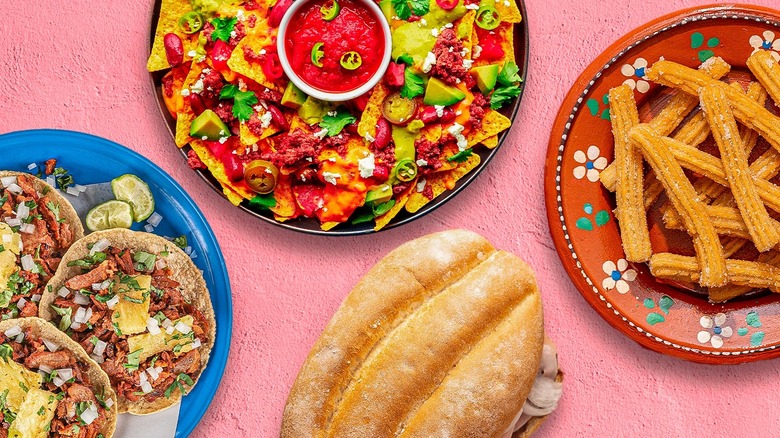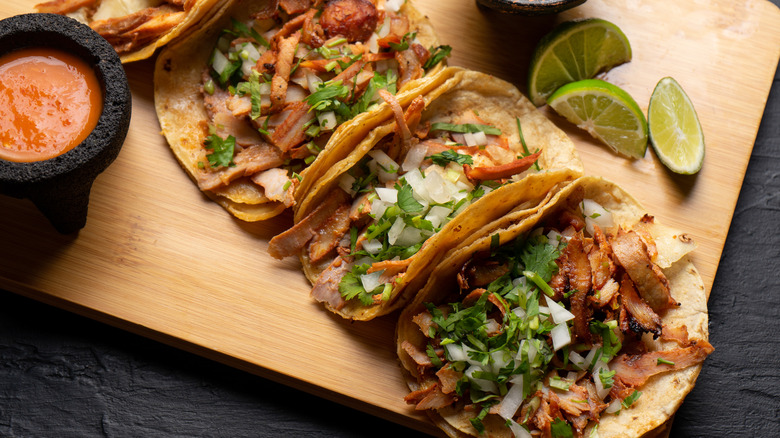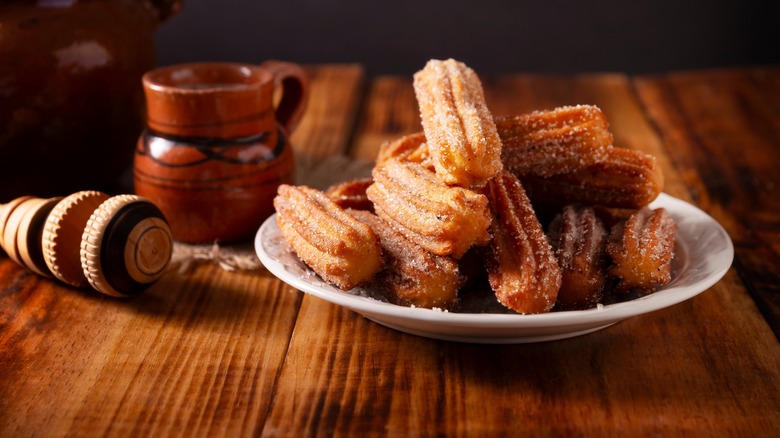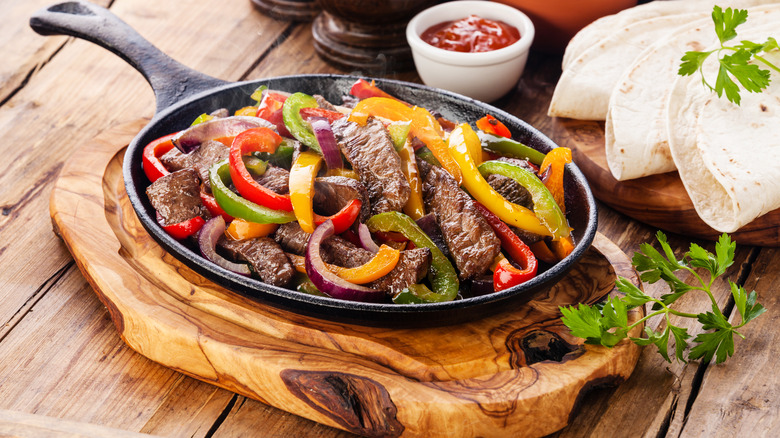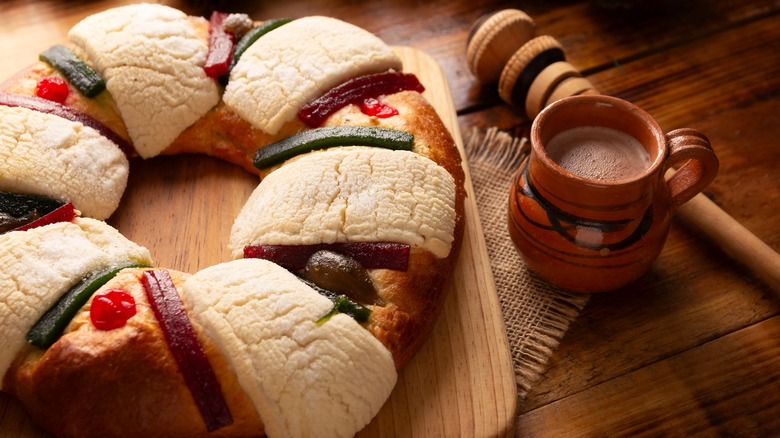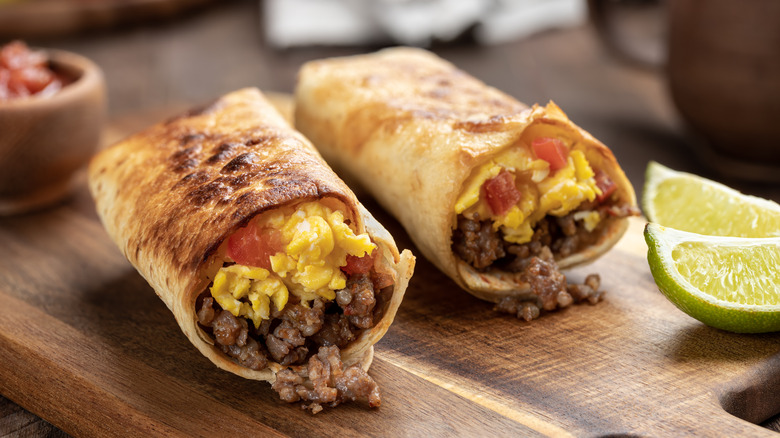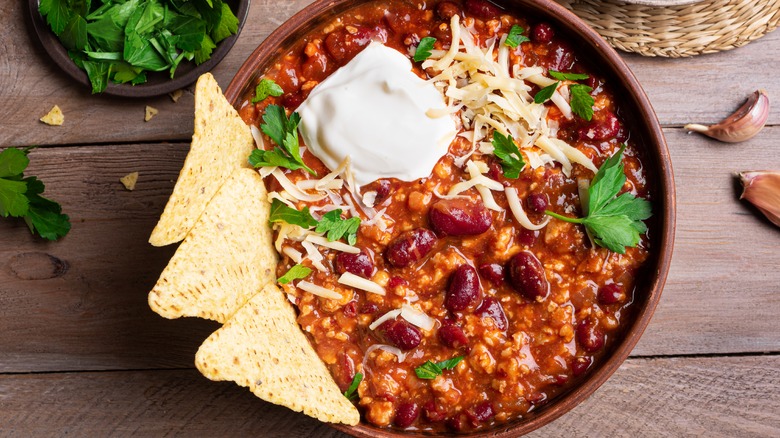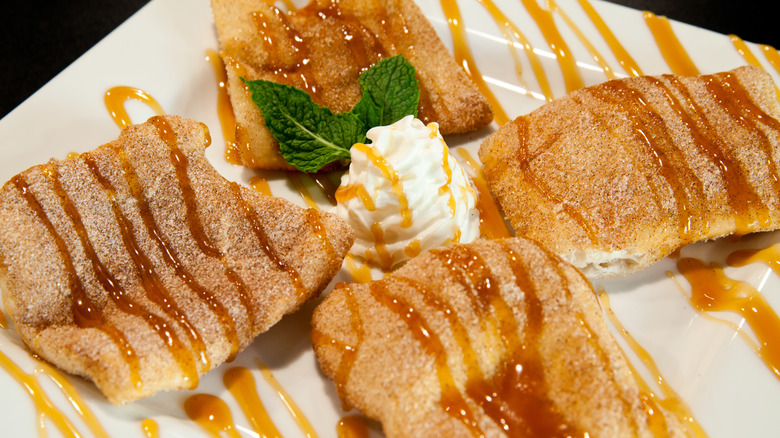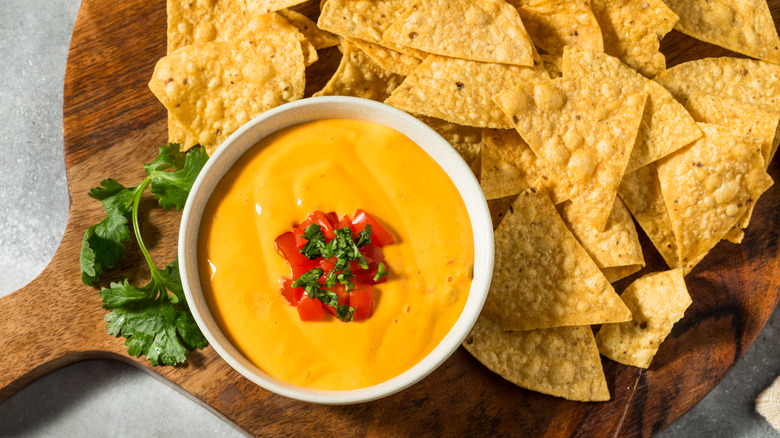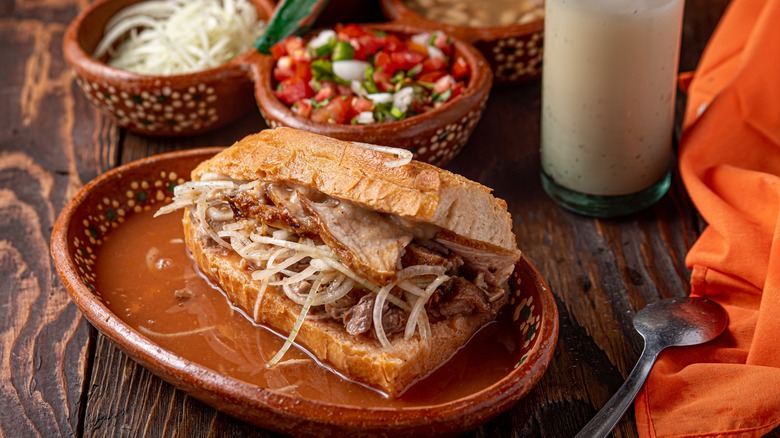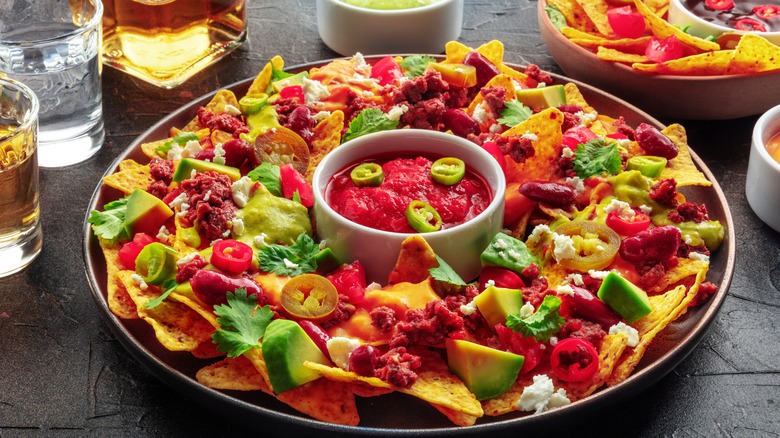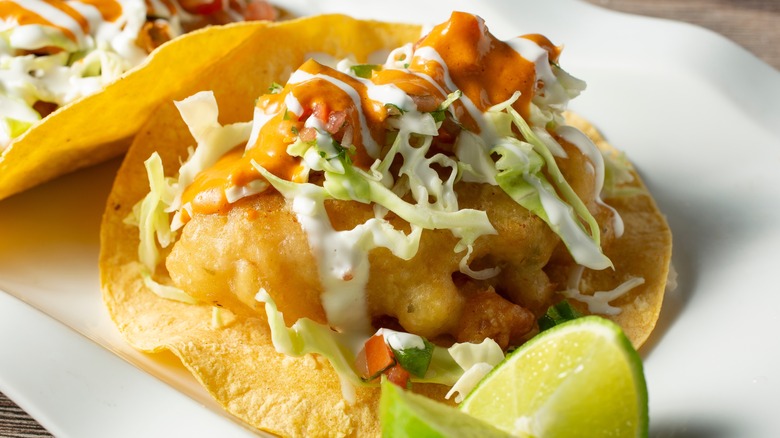The International Roots Of 11 Popular Mexican Dishes
There's no disputing that Mexican food is loved worldwide. Whether you're craving tacos, enchiladas, or guacamole, chances are you can probably find a Mexican restaurant close to you. That's especially true if you're in the States where Mexican food now makes up 10% of all U.S. restaurants. Of course, the best place to get authentic Mexican food is in Mexico. That's where you'll find dishes made with recipes that have been passed down for generations. However, you might be surprised to know that some of your favorite Mexican dishes didn't actually originate in Mexico.
Mexico has a long and colorful culinary history. The country was the birthplace of domesticated chilies, tomatoes, and corn. Ancient cultures used these ingredients in a wide variety of dishes, many of which are still commonplace in Mexico today. When foreigners arrived on Mexico's shores, they introduced new ingredients and cooking techniques. Like many food cultures around the world, Mexican cuisine has incorporated international influences over the centuries.
When you think of Mexican foods that originated elsewhere, Tex-Mex cuisine is probably the first thing that comes to mind. Given that Texas was once part of Mexico and now shares a border with the country, it makes sense that certain dishes would cross over both ways. There are also Mexican dishes that came to the country by way of countries like Japan, Spain, and Lebanon. If you're curious about the history of your favorite Mexican foods, these are the surprising international roots of some popular Mexican dishes.
Tacos al pastor
Visit any city or town in Mexico and you'll likely find a tacos al pastor stand somewhere. These tasty tacos feature pork that's been marinated in a blend of citrus juice and spices, then roasted on a spit called a trompo until crispy on the outside and juicy inside. The meat is shaved directly off the spit and served in corn tortillas with toppings like roasted pineapple, chopped onions, and cilantro. Lashings of fiery salsa are optional. Many say it's the quintessential Mexican dish. But is it really?
If the method of cooking al pastor meat looks strikingly similar to the way shawarma is prepared, that's because the two are intricately connected. During the early 1900s, waves of Lebanese immigrants settled in Mexico and introduced the shawarma cooking technique of stacking lamb meat on a vertical spit, roasting it, and serving it on a pita. The meaning of al pastor translates to "shepherd's style" in Spanish, which is a nod to the lamb the Lebanese used to make their "tacos Árabes."
While tacos al pastor may have its roots in the Middle East, Mexicans truly made it their own. For one, pork is used instead of lamb. In addition, the marinade features Mexican ingredients like chiles, achiote paste, and oregano. Then there is the juicy pineapple that gets roasted with the meat and, of course, the corn tortillas.
Churros
Mexican street food is often savory, but there's one sweet treat that you can find at markets and street corners all over the country and that's churros. The dish is so popular that there is even a designated National Churro Day on June 6. The recipe for churros begins with just a few ingredients like flour, baking powder, and oil. However, once the dough is piped into ultra-hot oil, it puffs up and crisps beautifully. Add a dusting of cinnamon sugar and some melted chocolate and you have a pretty divine dessert.
While these deep-fried pastries have become an iconic Mexican treat, the origin of churros is murky. Some say that churros are versions of a popular snack from China called youtiao and that Portuguese traders brought them back to the Iberian peninsula. Others say they were brought to Spain by the Moors and adapted by Spanish shepherds who wanted a quick and easy snack they could make while tending their sheep.
Regardless of where churros originated, we know that the Spanish brought them to Mexico. However, we have Mexico to thank for the addition of melted chocolate. In fact, we can thank Mexico for chocolate in general. The country is, after all, the birthplace of chocolate.
Fajitas
When many people think of Mexican food, fajitas come to mind. The dish typically includes strips of meat like steak, pork, or chicken sauteed with onions and bell peppers. It's often served on a sizzling platter with a side of flour tortillas and condiments like guacamole, sour cream, and salsa. Today, you can find fajitas at restaurants all across Mexico, but it wasn't always that way. The roots of the dish can be traced back to Texas in the first half of the 20th century.
The first reports of fajitas come from the 1930s. At that time, Mexican vaqueros (cowboys) working on ranches in Texas were often paid in throwaway cuts of meat like skirt steaks. The ranch hands would cook the meat over coals and eat them in tortillas. According to Texas Monthly, a woman named Otilia Garza kicked off the fajita craze when she started selling them at her Round-Up Restaurant in Pharr, Texas. She also added the sizzling platter and condiments that we know and love today. When the Hyatt Regency in Austin put fajitas on the menu, the dish exploded in popularity.
Rosca de Reyes
Three Kings Day falls on January 6, and for many Mexicans, it's celebrated with a colorful bread called Rosca de Reyes. The sweet, brioche-like bread is made with ingredients like butter, flour, sugar, and milk. The soft bread is shaped like a wreath and it's typically topped with candied fruits like cherries and quince. The bread also contains a figurine of baby Jesus hidden inside. Families gather around to cut the bread and the person who gets the slice with baby Jesus in it is on the hook for throwing a tamale feast on Día de la Candelaria (February 2).
Rosca de Reyes may be an integral part of Mexico's culinary tradition today, but it's not unique to Mexico. Just like king cake in Louisiana and gâteau des rois in Québec, this holiday treat has roots in Europe. The ancient Romans celebrated the winter solstice with Saturnalia, a festival that involved decorations, gifts, and cakes with objects like coins or beans hidden inside. The person who got the special object in their slice of cake would be named king of the house for the day. Many Saturnalia traditions were incorporated into Christian holidays, including eating cakes and bread with hidden treats like Rosca de Reyes.
Breakfast burritos
When many people want a hearty handheld breakfast, they turn to the breakfast burrito. This versatile dish can feature a wide range of ingredients, but the most common include scrambled eggs, cheese, potatoes, and meat wrapped up in a flour tortilla. Some people add roasted chilies, while others douse the burrito with green or red salsa. It sounds like a pretty classic Mexican dish and one that's probably been around forever. However, the breakfast burrito only recently came into the culinary lexicon. It's origin? Santa Fe, New Mexico.
So, when did breakfast burritos first become a thing? According to the Santa Fe New Mexican, a Santa Fe restaurant called Tia Sophia's was the first to coin the term when the owner added it to the menu in the 1970s. However, the owners are quick to point out that the dish wasn't invented at the restaurant, as New Mexicans have a long history of wrapping up breakfast foods in flour tortillas.
To be fair, some northern Mexican states like Nuevo Léon, Tamaulipas, and Sonora have breakfast dishes that feature flour tortillas filled with ingredients like eggs, potatoes, and meat. However, the traditional dishes are more like tacos than burritos. The super-stuffed breakfast burritos that you find across the States and south of the border likely have their roots in New Mexico.
Chili con carne
Packed with savory meat simmered with chilis and spices, chili con carne is the ultimate comfort food for those who can handle the heat. But don't let the Spanish name fool you — chile con carne is not technically a traditional Mexican dish. It's actually a Tex-Mex creation. In fact, it's the official state dish of Texas. The name simply means "chili with meat," and while the dish is popular on both sides of the border, research points to its birthplace being in the United States.
The true origins of chili con carne are hotly contested, but many believe it was born in San Antonio, Texas. Historians point to the fact that some of the original settlers of the city were from the Canary Islands, and they likely brought their recipes for a spicy Canarian stew featuring meat, chilis, and cumin with them. Records also show that by the 1800s, chili stands were commonplace at the San Antonio Military Plaza and were run by women called the "Chili Queens."
Considering that San Antonio was once part of Mexico and still has a rich Tejano culture today, it's easy to see how the dish became associated with Mexico and how it spread to points further south. However, Texas has some pretty solid evidence for claiming this dish.
Sopapillas
Sopapillas (aka sopaipillas) are pillowy triangles of fried dough that are perfect for sopping up sauces. They can also be stuffed with meat, chiles, and cheese or enjoyed as a dessert with honey drizzled on top. They're popular in northern Mexican states like Chihuahua and Sonora, although New Mexico is the epicenter of sopapilla culture. You can also find them in Texas and Arizona. But where did these puffy fried treats come from?
There are two main origin stories for sopapillas. One is that they are a version of Native American fried bread. This theory has legs, as you can find indigenous fried bread dishes across North America, from fry bread in the south to bannock in the north. In the south, fry bread is tied to the story of the Long Walk the Navajo people were forced to make to Bosque Redondo. The U.S. government only supplied scant rations, so fry bread was a way to make the rations last longer.
The other theory for sopapillas is that they were introduced by the Spanish when they settled in the region that is now New Mexico. Some believe that sopapillas are directly linked to a fried dough dish called sopaipas from the city of Cordoba in Spain. That would explain the name. This theory also proposes that the dish may have Moorish influences from North Africa and the Middle East. Regardless of where they originated, sopapillas are now widely considered a Southwestern staple.
Queso
Featuring smooth, melted cheese with green chiles and tomatoes, queso is a popular party dip and a common appetizer at many Tex-Mex restaurants. Technically, it's called chile con queso, which may lead you to believe the cheese has Mexican origins. While you can find versions of this gooey, cheese dip in Mexico, the queso dip that most Americans know was born in the United States.
No one knows exactly when chile con queso was created, but many point to The Original Mexican Restaurant in San Antonio, Texas as being one of the first to popularize it. Opened by Otis Farnsworth in 1900, the restaurant aimed to serve Mexican-style food to Anglo clientele. The chile con queso may have been inspired by a Mexican dish called queso fundido, which is similar to fondue. However, there are many differences between queso and queso fundido.
Queso fundido is typically made with soft, white cheese like Chihuahua or asadero. It may have chorizo or mushrooms mixed in, and it's meant to be spread onto soft flour tortillas. Classic chile con queso, on the other hand, is typically made with bright orange, processed American cheese like Velveeta. Many people also make queso dip with canned Ro-Tel tomatoes, which also include chiles. In addition, queso is usually served with tortilla chips on the side for dipping. It may resemble queso fundido, but chile con queso is unapologetically Tex-Mex.
Tortas
Tacos may be the most sought-after Mexican street food, but tortas aren't far behind. Similar to sandwiches, these handheld eats feature bread filled with meat, cheese, vegetables, and an array of condiments like crema and salsa. Just like tacos, they're incredibly diverse with multiple variations ranging from chorizo to carnitas, breaded cutlets, and tamal tortas. Unlike tacos though, tortas did not originate in Mexico.
To understand how tortas became part of the Mexican culinary landscape, we have to go back to the time when wheat was introduced to the country. During the 14th century, Spanish monks brought wheat over to produce bread for Catholic ceremonies. Those first loaves of bread paved the way for tortas. However, many believe it wasn't until the French invaded in the 19th century that bread — particularly rolls and baguettes — became popular in Mexican food culture.
Sandwiches can be found around the world, but Mexican tortas are truly unique. Take for example, the torta ahogada from Guadalajara, which features a sourdough roll filled with pork carnitas and onions, then "drowned" in a spicy chile de arbol sauce. The pambazo is another distinctively Mexican creation featuring a telera roll filled with chorizo, queso fresco, and mashed potatoes. The torta is doused with guajillo chili salsa and fried until hot and slightly crispy.
Loaded nachos
Nachos are a Mexican creation, but they came about from a blending of two cultures. It all started in the Mexican border town of Piedras Negras in 1943 when a group of American women visited the Victory Club for drinks and a bite to eat. Chef Ignacio "Nacho" Anaya whipped up an inspired dish of fried corn tortillas layered with Colby cheese and topped with jalapeños. He called them "Nacho's Special." The ladies loved them, and word soon spread about this delicious dish.
Many attribute San Antonio businessman Frank Liberto for catapulting nachos onto the U.S. food scene. He envisioned taking nachos to the masses, so he created a nacho cheese sauce that could be warmed and quickly ladled over thick tortilla chips. The nachos with runny cheese sauce and jalapeños first made their appearance at the Texas Ranger stadium in 1976 and became an instant hit.
From there, nachos went wild in the United States and eventually evolved into loaded nachos piled high with everything from chicken to ground beef, pulled pork, beans, corn, guacamole, sour cream, and cheese. In Mexico, nachos have pretty much stayed true to the original with just the core ingredients of cheese and jalapeños. Loaded nachos are far from the norm. In fact, many Mexicans consider loaded nachos an American creation.
Baja fish tacos
It's hard to think of a more perfect beachfront snack than Baja fish tacos. They're easy to eat without utensils, light enough that they won't weigh you down, and filled with delicious crispy fish that offers a taste of the ocean. As the name suggests, they hail from the Baja California peninsula — Ensenada, Mexico, to be exact. But these tasty fish tacos were actually inspired by another dish from the other side of the Pacific Ocean.
Many believe that Baja fish tacos are an adaptation of Japanese tempura. Around the turn of the 20th century, Japanese fishermen began making their way to Baja California to fish in the fertile waters. Many settled on the peninsula, bringing their culinary traditions with them. Tempura typically consists of seafood and vegetables dipped in a light batter and deep-fried. The technique worked particularly well with local Baja catches like angel shark and dogfish because the dense meat can withstand the frying process.
Like many foreign dishes introduced to Mexico, the tempura-style fried fish in Baja transformed into something distinctively Mexican. Local cooks swapped rice flour for wheat flour and served the fish in corn tortillas. In addition, they added colorful toppings like shredded red cabbage, crema, and pico de gallo. Other toppings can include chipotle crema, habanero salsa, and a squeeze of lime. What you get is a regional taco that's crispy, creamy, fresh, and ultra-satisfying.
